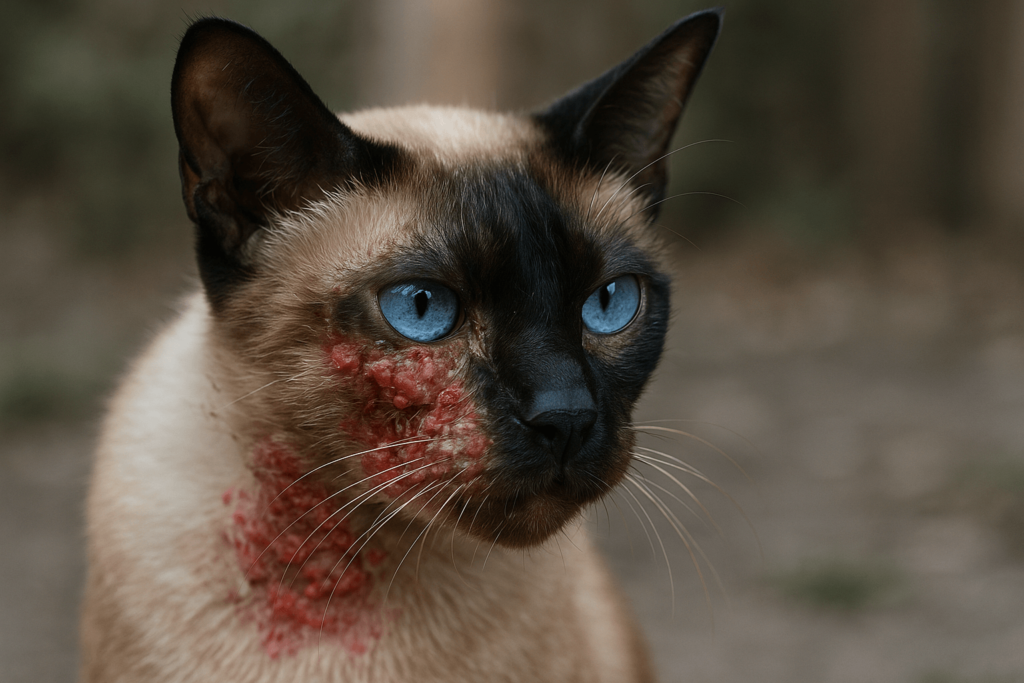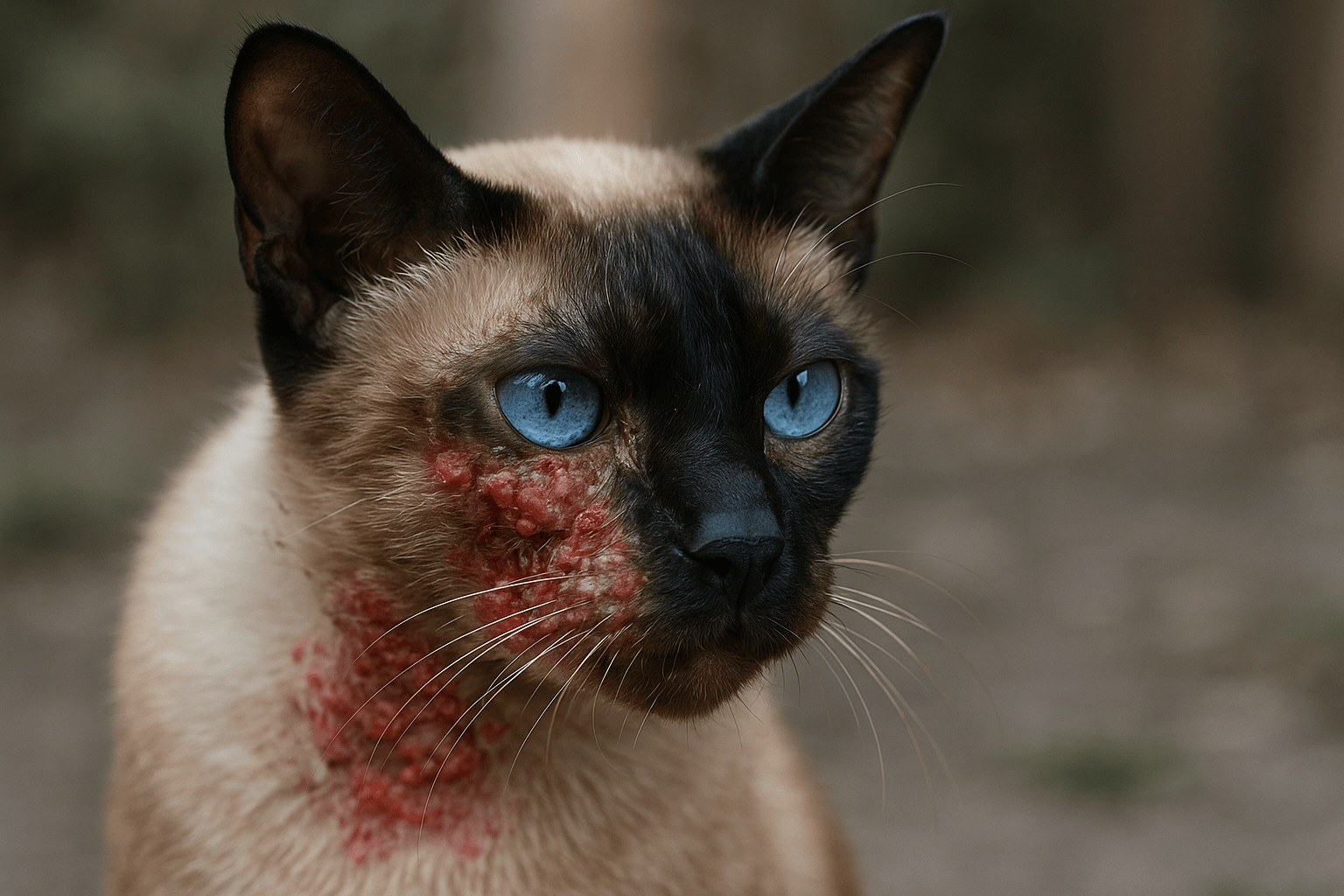Siamese Cat Skin Problems: Understanding the Unique Risks and How to Protect Your Feline
Siamese cats are known for their striking blue eyes, sleek coats, and vocal personalities — but beneath their elegant exterior lies a genetic predisposition to delicate skin. Unlike many other breeds, Siamese cats are more susceptible to a range of skin conditions that can cause discomfort, hair loss, and even systemic health issues if left unaddressed. From allergies to autoimmune reactions, understanding Siamese cat skin problems is not just about aesthetics — it’s essential for their long-term well-being. This guide explores the most common skin issues affecting Siamese cats, their root causes, and how you can prevent, recognize, and manage them with confidence.
Why Siamese Cats Are Prone to Skin Issues
Siamese cats don’t just have unique looks — they have unique biology. Their genetic makeup makes them more sensitive to environmental and dietary triggers, leading to a higher incidence of skin-related conditions compared to other breeds.
Thin Coat and Light Pigmentation: Siamese cats have short, fine fur and minimal melanin in their skin, making them more vulnerable to sunburn, UV damage, and irritants.
Genetic Predisposition to Allergies: Many Siamese carry genes linked to atopic dermatitis and food sensitivities, which often manifest first as skin inflammation or itching.
High Metabolic Rate: Their energetic metabolism can increase skin turnover and sensitivity, making them react more intensely to allergens or parasites.
Stress-Reactive Physiology: Siamese are emotionally attuned cats — stress directly impacts their immune system, triggering flare-ups like eosinophilic granuloma complex.
Dermatological Sensitivity to Chemicals: Household cleaners, perfumes, and even flea treatments can provoke severe reactions in Siamese cats due to their delicate skin barrier.
Recognizing these inherent vulnerabilities is the first step toward proactive care. What might be a minor irritation in another breed could signal a serious issue in your Siamese.

Top 5 Most Common Siamese Cat Skin Problems
Siamese cats are more likely than other breeds to develop specific dermatological conditions. Identifying these early can prevent chronic discomfort and secondary infections.
Allergic Dermatitis: Often triggered by food (fish, chicken, dairy), pollen, dust mites, or flea saliva — causes redness, hair loss, and obsessive licking, especially along the back and base of the tail.
Eosinophilic Granuloma Complex (EGC): An immune-mediated condition appearing as raised, ulcerated lesions on the lips, chin, or inner thighs — common in Siamese due to their hyper-reactive immune systems.
Feline Acne: Blackheads on the chin, caused by blocked sebaceous glands — exacerbated by plastic food bowls and poor hygiene, which Siamese are particularly sensitive to.
Sunburn and Solar Dermatitis: Their light-colored skin, especially on ears and nose, burns easily and can progress to squamous cell carcinoma if exposed to prolonged UV light.
Fungal and Bacterial Infections: Thin skin and frequent scratching create entry points for yeast (Malassezia) and staph bacteria, leading to hot spots, odor, and crusting.
These conditions rarely occur in isolation. They often feed into each other — an allergic reaction leads to scratching, which causes infection, which increases stress, which worsens the allergy. A holistic approach is key.
Check this guide 👉Himalayan Siamese Cat: Best 7 Expert Tips!
Check this guide 👉Siamese vs Burmese Cat: Best 7 Expert Tips!
Check this guide 👉Siamese Maine Coon Mix: Best 7 Expert Tips!
| Skin Problem | Key Signs to Watch For |
|---|---|
| Allergic Dermatitis | Excessive grooming, bald patches, red inflamed skin, scabs near tail or groin |
| Eosinophilic Granuloma Complex | Raised, yellowish ulcers on lips or paws, swelling in mouth, licking or biting affected areas |
| Feline Acne | Blackheads on chin, greasy appearance, swollen or inflamed chin, occasional pus |
| Solar Dermatitis | Red, peeling skin on ears, nose, or eyelids, crusting, hair loss in sun-exposed areas |
| Yeast or Bacterial Infections | Musty odor, greasy skin, dark discoloration, constant scratching, hot spots with moisture |
How Environmental Factors Trigger Skin Reactions in Siamese Cats
Your home environment plays a critical role in your Siamese’s skin health. Even seemingly harmless habits can become triggers for chronic dermatitis.
Plastic Food and Water Bowls: These harbor bacteria and can cause chin acne or contact dermatitis — ceramic or stainless steel are far safer choices.
Scented Candles and Air Fresheners: Strong fragrances irritate Siamese cats’ sensitive respiratory and skin systems — opt for unscented or natural alternatives.
Synthetic Fabrics and Laundry Detergents: Chemical residues on bedding or blankets can cause itching and rashes — use fragrance-free, hypoallergenic detergents.
Indoor Air Quality: Dust, mold, and poor ventilation increase airborne allergens — consider HEPA filters and regular cleaning to reduce exposure.
Sun Exposure Through Windows: UV rays penetrate glass — your Siamese lounging on the windowsill is at risk for solar dermatitis, even on cloudy days.
Small changes in your home’s environment can dramatically reduce the frequency and severity of skin flare-ups. Think of your cat’s skin as a mirror — it reflects what’s happening around them.
Dietary Triggers and How to Choose the Right Food
Food is one of the most common — and controllable — causes of skin problems in Siamese cats. Many commercial diets contain fillers and proteins that trigger immune overreactions.
Avoid Common Allergens: Chicken, beef, dairy, fish, and soy are frequent culprits — try novel protein diets like duck, rabbit, or venison.
Look for Limited Ingredient Diets (LID): These formulas contain fewer additives and are easier to trace for allergen identification.
Prioritize Omega-3 Fatty Acids: Found in fish oil or flaxseed, these reduce inflammation and support skin barrier repair.
Avoid Artificial Preservatives: BHA, BHT, and ethoxyquin can irritate sensitive skin — choose natural preservation like mixed tocopherols (vitamin E).
Hydration Matters: Wet food provides moisture that supports skin elasticity and helps flush toxins — aim for at least 50% of daily intake as wet food.
An elimination diet under veterinary supervision is often the most effective way to pinpoint food triggers. Don’t guess — test.
Stress and Its Direct Link to Skin Conditions in Siamese Cats
Siamese cats are emotionally intelligent — and their skin often bears the brunt of emotional stress.
Changes in Routine: Moving homes, new pets, or even rearranging furniture can trigger stress-induced dermatitis or overgrooming.
Lack of Mental Stimulation: Boredom leads to compulsive licking and hair loss — especially on the belly and inner thighs.
Social Isolation: Siamese thrive on interaction. Being ignored or left alone for long periods can elevate cortisol, weakening the skin barrier.
Loud Noises or Visitors: Sudden sounds or unfamiliar people can cause acute stress responses that manifest as skin redness or itching.
Inconsistent Caregiving: Inconsistent feeding, grooming, or attention increases anxiety — and with it, skin flare-ups.
Create a calm, predictable environment. Use pheromone diffusers, provide high perches, and spend at least 20 minutes daily in quiet, focused interaction.
Signs Your Siamese Cat Needs Immediate Veterinary Care
Not all skin issues are mild. Some require urgent medical attention to prevent permanent damage or systemic illness.
Open Sores or Ulcers: Especially on lips, nose, or paws — may indicate EGC or severe allergy.
Foul Odor from Skin or Ears: Strong, cheesy smell suggests yeast overgrowth or bacterial infection.
Hair Loss in Patches with Red, Scaly Skin: Could be ringworm, mange, or autoimmune disease.
Lethargy, Loss of Appetite, or Fever Alongside Skin Issues: Indicates possible systemic infection or immune disorder.
Skin Thickening or Darkening Over Time: Especially on ears or bridge of nose — potential early sign of squamous cell carcinoma.
If you notice any of these signs, schedule a vet visit immediately. Early intervention saves your cat from pain and prevents costly, long-term treatment.
Preventive Care Routine for Siamese Cat Skin Health
Prevention is always better than cure — especially for a breed with delicate skin.
Weekly Brushing: Gently remove dead hair and distribute natural oils — use a soft rubber brush or grooming glove.
Monthly Nail Trims: Prevents self-inflicted scratches during grooming sessions.
Hypoallergenic Bathing (Every 6–8 Weeks): Use vet-recommended oatmeal or chlorhexidine shampoo — never human products.
Regular Flea Prevention: Even indoor cats need monthly topical or oral flea control — one bite can trigger a severe reaction.
Annual Skin Screenings: Ask your vet to check for early signs of solar dermatitis or lumps during routine exams.
Consistency is everything. A simple 5-minute weekly routine can prevent months of suffering.
Canned Pumpkin for Cat Diarrhea: Best 7 Expert Tips! Natural remedy to firm stools, soothe upset bellies, and support gut health safely.
Can a Cat Give You Scabies? Best 7 Expert Tips! Discover the truth about feline mites, human skin risks, and how to protect yourself—without panic.
Cat Flea vs Human Flea: Best 7 Expert Tips! Discover the truth about bites, species, and how to eliminate infestations for good.
Weird Cat Behaviors: Best 7 Expert Tips! Discover why cats do strange things—and how to understand, not punish, their instincts for a happier home.





